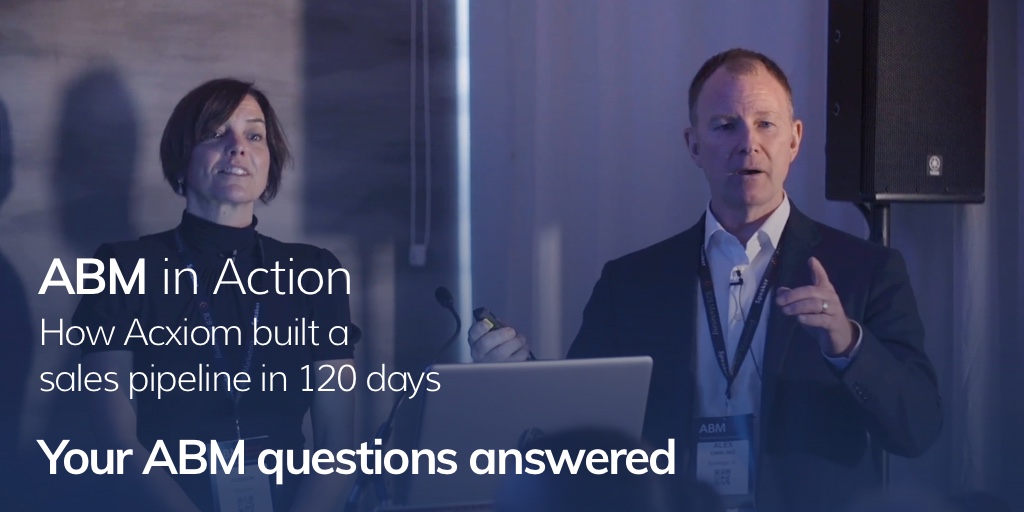ABM in action: How Acxiom built a sales pipeline in 120 days - Your questions answered
Acxiom and strategicabm seminar: “ABM in Action: How Acxiom Built a Sales Pipeline in 120 Days” ended with a lively Q&A session.
With an audience of B2B Marketers eager to ask Jo Robson and Alex Embling questions about the ABM programme and its implementation in their own businesses, these are the Q&A highlights.
Click on a question below to go to the answer or scroll through the entire ABM Q&A below:
Your ABM Q&As Answered
1. What has been the internal feedback at Acxiom on the success of this ABM programme?
2. What was the main sales and marketing alignment you had to overcome?
4. How did you enable SDRs to follow up leads? Did you share the ABM campaign with them?
5. Is there an ideal mix between first and third-party data use for ABM programmes?
6. What were the title levels you were targeting? E.g., C-Suite, Sales Director, etc.?
7. How did you identify the right contacts within your target accounts?
9. How much did the campaign cost? They seem like impressive results?
13. Did the European campaigns run in the English language only?

Your ABM Questions Answered: How Acxiom Built a Sales Pipeline in 120 Days
- Audience: What has been the internal feedback at Acxiom on the success of this ABM programme?
Jo: The feedback has been very positive - so much so that as we mentioned earlier, we are expanding our ABM programme into new clusters (industry verticals) for the current blended program, with a view to launch our first one-to-one ABM programme in late 2020. In addition, several other Acxiom regions have also expressed interest and we are running a number of awareness sessions with a view to launching this programme in the US.
- Audience: What was the main sales and marketing alignment you had to overcome?
Jo: As you all no doubt know, ABM only works if sales and marketing work seamlessly together. Moving from a lead and contact focus to an account level focus has naturally brought our sales and marketing teams together. We were very fortunate to count from day one with the support of the Sales Director of our UK operation. She was pivotal to the success of this programme, ensuring that her teams were onboard and working the leads that were generated from this campaign in a timely manner. This success can be seen in everything from the social selling campaign where we plugged sales teams into our systems to automate part of the process through to the relationship with the SDRs and lead nurturing.
- Audience: What do you mean when saying ‘personalisation’ at the different levels of one-to-many and one-to-one?
Alex: The level and type of personalisation changes dramatically as you move from demand generation programmes through to one-to-many, one-to-few and ultimately one-to-one ABM. Demand generation and one-to-many is personalised at the “Buyer Persona” level whereas as you move through to one-to-few, you are now personalising at the Account level (some 20-25%), while one-to-one is - as the name suggests - 100% personalised.
- Audience: How did you enable SDRs to follow up leads? Did you share the ABM campaign with them?
Jo: Absolutely. The SDRs received a detailed briefing of the ABM campaign and its objectives as part of the onboarding process. This briefing included a comprehensive overview of Acxiom, the key verticals we were targeting, our key differentiators and USPs for each of these verticals as well as detailed guidance, templates and coaching for their sales conversations.
There was a constant flow of information between all teams (Marketing, Business Development and Sales Development Reps) which provided insight on account and contact engagement and provided a forum for invaluable information exchange and learning.
- Audience: Is there an ideal mix between first and third-party data use for ABM programmes?
Alex: We typically look for the intersection between both. You can obviously run campaigns on first-party data primarily, if you don't have first-party data, use third-party data in isolation to give you a better steer on which accounts to go after. If you have a list of accounts, overlay it with third-party data just to prove that your list of accounts is worth targeting.
- Audience: What were the title levels you were targeting? E.g., C-Suite, Sales Director, etc.?
Jo: Below C-Suite. It’s Marketing Director and below I’d say. And then analytics, CRM, Database those kinds of people that we’re after. We are embarking on a C-Suite campaign this year because we haven't cut through that yet. It’s much harder to target the C-Suite.
- Audience: How did you identify the right contacts within your target accounts?
Alex: That’s where the buyer personas come in. You need to have that historical sales data to say “these guys are typically involved in the decision making process”. Then, overlay that on top of the accounts. The use of third-party data quite often gives you the office locations where the activity is happening as well, which can give a really good focus.
- Audience: Interesting to see demand generation sitting above one-to-many on one of the slides. Are you treating demand gen as pure awareness or are you targeting specific accounts?
Alex: It’s a target audience. And this isn't necessarily the case for Acxiom. But what we’re seeing in the market is (with the concept of Account-based Marketing) if you’re selling into mid-market and enterprise, with a more complex sales cycle length there is a lot of pressure on traditional demand generation programmes to still deliver the leads. So the recommendation at this early stage of ABM adoption is to have that blended ABM approach, as it allows you to pilot a more targeted account-focussed programme, while you’re keeping the business satisfied with leads still coming in at the same time.
And that’s not to say that demand generation doesn't work, because of course, it does. But it’s about de-risking really, because it’s all about ROI - investment in, ROI out - and a balanced approach is what we're seeing in the early adoption phase of ABM.
Jo: Just to add to that. With the demand gen, we don’t just “chuck them over the fence” to an SDR and say “call them up!”, they go into a Marketo engagement programme. So they’re nurtured again with the some of the assets and case studies that we have, so we’re nurturing them along the way, and developing that relationship to maybe get to that one-to-many or one-to-few stage.
Alex: Absolutely. You can also then jump into your third-party platform and validate that those accounts are active in other related areas as well, and not just with your brand. So it helps across all these data points.
- Audience: How much did the campaign cost? They seem like impressive results?
Alex: Full disclosure. We’re pretty transparent as we have a very open agency-client relationship. Acxiom invested with us over that four-month period around £55,000, plus some media spend. And that [investment] generated around £1.5 million [in pipeline].
- Audience: So to one-to-one marketing its great, we all acknowledge that if it’s existing accounts, great. But what if you want to do more growth marketing and new-level acquisitions?
Jo: We recently had this question from our New Logo team who were actually answering an RFP, so already in that process. And we debated this, because we don’t know them [the prospect] well, we’re just answering an RFP and there could be ten of us answering an RFP. So you’ve really got to consider this. I’d rather go to an existing account, where you can grow more and you know you can grow more in that account because you can see the gap analysis and the whitespace. RFPs could just be looking for a pricing comparison, and you’d have wasted all that [time and] money. Whereas you know with an existing account that they are embedded in your organisation already.
- Audience: So there are reactive sales and proactive sales. And you are leaning more towards proactive sales where you know there is a demand, and this is your target that you need to grow, but new logos?
Alex: So you have a very clear Ideal Customer Profile that you want to go after? That comes back to making sure the list of accounts that you are going after isn’t just plucked out of the air. That’s very high risk with very low potential for return. Reports reckon that only 5% of the market is ever in an active buying journey, so you have 100% of your ICP globally, only 5% of them are ever looking to buy. It’s making sure you use that first-party- third-party data.
- Audience: So your third-party data through Cyance - your intent. Did you use that just for account selection? Or did you use the information from it to inform your content?
Alex: We used it to align with the content strategy. We also used it in our social selling lead follow up as well - so when our SDRs have been plugged in at that point in the campaign process, they also used the data from our third-party intent platform, that gives that account level insight, to add a lighter touch (because one-to-few isn’t one-to-one so we don’t want to go deep into the accounts) and up the level of personalisation enough so that our message resonated with that account.
- Audience: Did the European campaigns run in the English language only?
Jo: Yes. At this stage, the campaign has only been run in English.




